Side Menu:
Fifth Officer Harold Lowe
- Collapsibles and Carpathia
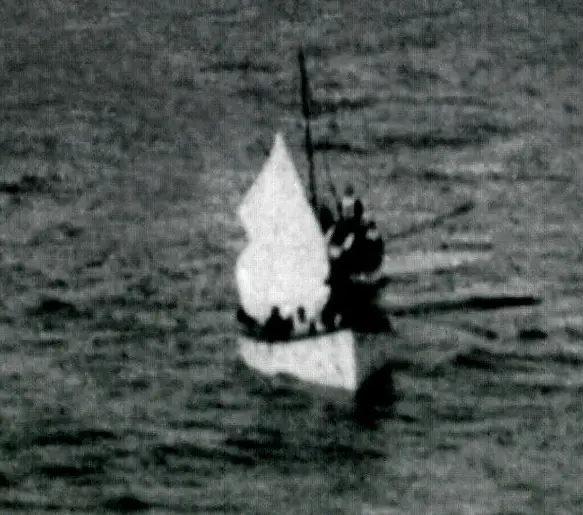
A rare image of Lifeboat 14, with Lowe at the helm, approaching the Carpathia
At some point the flotilla that Lowe had carefully organised seperated, according to Sara Compton, who had been transferred from lifeboat 14 to a collapsible: "I now found myself" she said, "in the stern of a collapsible boat. In spite of Mr. Lowe's warning the four small boats began to separate, each going its own way. Soon it seemed as though our boat was the only one on the sea. We went through a great deal of wreckage."("The Truth About the Titanic" by Archibald Gracie)
In the end, Lowe was satisfied that he could not find anyone else alive to rescue: "I left my crowd of boats somewhere, I should say, about between half past 3 and 4 in the morning, and after I had been around it was just breaking day, and I am quite satisfied that I had a real good look around, and that there was nothing left." (US Inquiry, Day 5)
AB Frank Evans said that Lowe told the men: "Have a good look around, and see if you can see anybody alive, at all."... The officer said, "Hoist the sail forward." I did so, and made sail… on the foremast; and we altered the course into the direction of this collapsible boat which had been swamped. On the way down we picked up another collapsible that had some women and children in it, and took her in tow, and then we sailed to this sinking boat." (US Inquiry)
Collapsible D
Lowe described taking collapsible D in tow: "And by and by, I noticed a collapsible boat, and it looked rather sorry, so I thought, "Well, I will go down and pick her up and make sure of her." So I went about and sailed down to this collapsible, and took her in tow." Lowe recognised one passenger in the collapsible - "Mrs. H. B. Harris, of New York. She had a broken arm" (US Inquiry, Day 5)
John Hardy, who was in collapsible D, that was towed by Lowe:
Officer Lowe then returned with his crew back to the ship to pick up all he could. I found out afterwards he had picked up some. We hung around then until dawn, until we sighted the Carpathia, pulling now and again. We were towed up by Mr. Lowe with a sail to the Carpathia, not having enough men in the boat to pull. There was only just this quartermaster and myself, two firemen, and about four gentlemen passengers, and the balance were women and children….Bright was the quartermaster, and he took the tiller. He was using an oar to steer by. I myself pulled with all my might... He [Lowe] returned, I think, with seven. I think three died.(US Inquiry)
First class passenger Hugh Woolner also described Lowe approaching him while he was in collapsible D, after spotting the Carpathia:
She [the Carpathia] seemed to come up very slowly and then she stopped. Then we looked out and we saw that there was a boat alongside her, and then we realized that she was waiting for us to come up to her instead of her coming to us, as we hoped. Then, just at that time, when we began to row toward the Carpathia, Mr. Lowe came down with his boat under sail, again, and hailed us and said, "Are you a collapsible?" We answered, "Yes." He said "How are you?" I said, "We have about all we want." He said, "Would you like a tow?" We answered, "Yes we would." So he took our painter and towed us away from the Carpathia, and then we looked and saw that there was another little group of people standing up in the sea who had to be rescued, and there were about… They were standing on an upturned boat."
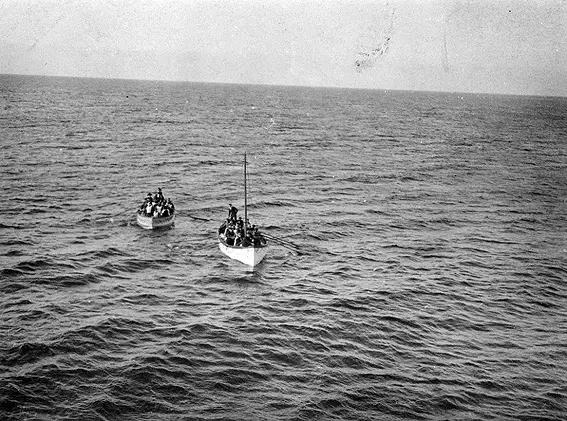
Lifeboat 14 with collapsible D in tow, and Lowe standing, approaches the Carpathia. (Click image to enlarge)
Mrs Rene Harris, a first class passenger in collapsible D, remembers how she first heard Lowe approach:
We had been drifting about an hour when out of the darkness came a voice - strong, ringing, youthful. "Anybody there?"… A boat swung round in front of us and we tied last. We started off with new strength. Now and then the young, strong voice rang back at us. "Everybody happy?" You're lied fast, don't worry." "Morning's coming." At little intervals the voice would call, "Any boats around? Tie up to me." In a short while the young voice of the invisible commander was guiding a flotilla of open boats. Heretofore we had been drifting about, the people in every boat trying to keep the others away from it. Now there was union. "How many can you take?" "Thirty." All right, tie up to me.(New York Evening Journal 11 May 1912, courtesy "On Board RMS Titanic," by George Behe)
Collapsible A and Gunfire
The "little group of people standing up in the sea who had to be rescued" as described by Woolner were the occupants of collapsible A, the last lifeboat that First Officer Murdoch had attempted to launch but it was not fitted into the davits in time and was swamped by the rising water as the boat deck went under. It was thus partially submerged.
Buly noted:
"In the morning, after we picked up all that was alive, there was a collapsible boat we saw with a lot of people, and she was swamped, and they were up to their knees in water. We set sail and went over to them, and in a brief time picked up another one."(US Inquiry)
Lowe described seeing collapsible A:
"I had taken this first collapsible in tow, and I noticed that there was another collapsible in a worse plight than this one that I had in tow. I was just thinking and wondering whether it would be better for me to cut this one adrift and let her go, and for me to travel faster to the sinking one, but I thought, "No, I think I can manage it"; so I cracked on a bit, and I got down there just in time and took off; I suppose, about 20 men and 1 lady out of this sinking collapsible….I left three bodies on it….As to the three people that I left on her - of course, I may have been a bit hard hearted, I can not say - but I thought to myself, "I am not here to worry about bodies; I am here for life, to save life, and not to bother about bodies," and I left them…The people on the raft told me they had been dead some time. I said, "Are you sure they are dead?" They said, "Absolutely sure." I made certain they were dead, and questioned them one and all before I left this collapsible... they were all up to their ankles in water when I took them off. Another three minutes and they would have been down"(US Inquiry, Day 5)
Evans mentioned this was the second occasion in which Lowe used his personal revolver, in this case warning the occupants of collapsible A not to swamp them:
"He fired four shots when we went to this boat that was in distress. She was half full of water, and they were up to their ankles in water. There was one collapsible boat that we had in tow, and we went over to this one that was swamped, sir. Three dead persons were left there, besides our taking two other people into our boat, and one woman." (US Inquiry)
According to Evans, Lowe pointed his revolver "in the air….He told people in this boat it was to warn them not to rush our boat when we got alongside." Evans described collapsible A as being spotted "about a mile and a half" away and Lowe firing his shots from "about 150 yards…he just mentioned the fact that they must not rush the boat, as it was liable to capsize her." (US Inquiry)
Alternatively, Scarrott said Lowe fired into the water:
"After we came back from the wreckage where we had taken one of those rafts in tow, Mr. Lowe emptied his pistol into the water; as regards the number of rounds left in it I cannot say, but I think he emptied five rounds out of it." (British Inquiry)
Mrs Rene Harris in collapsible D described how Lowe handled the difficulty of dealing with collapsible A and the need to threaten to "shoot the man who tries to get ahead."
At last I heard the voice grow tense. "Courage!" it called. "We're coming. There's a boat ahead. It's almost under. Call out to them. We're coming. Every voice among you call. Say we're coming!" I couldn't speak. I opened my lips but no words came. But from ours came a strange mixed chorus, full of sadness and yet of help. "We're coming," it said.
There's a boat ahead. It's almost under. Call out to them. We're coming. Every voice among you call. Say we're coming!" I couldn't speak. I opened my lips but no words came. But from ours came a strange mixed chorus, full of sadness and yet of help. "We're coming," it said.
Then we were nearly abreast the other. The boat had been pierced by a piece of wreckage. Its sides were within two inches of the surface. A woman and a dozen men were huddled close together. Some of them were in their night clothes.
They stood in the icy water up to their waists. Their faces looked like those of famished wild animals. The voice that had commanded us had a stern tone. I saw a revolver pointed at the boat.
"The woman first," said the voice. "I will shoot the man who tries to get ahead."
He swung her into the boat, a little woman dressed all in brown. She sank into the bottom of the boat like a drowned bird. The young officer still held the revolver pointed at the men in the sinking boat. "One man at a time," he warned. "Death to the man who makes a rush." So they were taken into the boat one at a time, and as the last was dragged in the other boat sank. With it went two stark figures. They were men who had died while drifting. They were men who had died while drifting.
In the darkness the voice kept on cheering. "Tie fast." "Tie up to me," it would say. When the first light came we were in an orderly little fleet. Looking toward the spot from which the voice came I saw a young man of 6 feet 2, very slender and sinewy. His face was clear cut and of the fine British race. He had keen, deep set, merry black eyes. His cap was tilted boyishly on one side. He looked like a college boy out on an early morning lark. It was his voice that told us there was a boat in sight. Over against the twin mountains of snow the sun rose just behind a ship.
"Call to her," said a voice from one of the boats.
"Wait for her to come after us. Don't go near the ice," warned another.
"I've taken command here," the voice that had cheered us through the night rang out sternly. "I intend to keep command because no one else seems to have sense enough to do it. Now, shut up. We will go to the boat. We can't expect her to come to us." (New York Evening Journal 11 May 1912, courtesy "On Board RMS Titanic," by George Behe)
Quartermaster Bright, in collapsible D being towed by Lowe, described coming across collapsible A:
"We saw a boat, one of the collapsible boats, that was awash, just flush with the water…and the same officer, Mr. Lowe, came back and took my boat in tow, because we had very few men to pull, and towed us down to this one that was just awash, and took 13 men and 1 woman off that…They had been singing out in the dark. As soon as it got daylight we could see them."
Bright also mentioned that they left the boat with "two dead bodies" and turned the swamped boat adrift - "there was no way to do anything with it. We left it there…With two dead bodies. They were covered up with a life belt over their faces."(US Inquiry)
Lowe also mentioned leaving "three bodies... I made the men on that collapsible turn those bodies over before I took them into my boat. I said, “Before you come on board here you turn those bodies over and make sure they are dead,” and they did so." (British Inquiry) In his written account Lowe also reiterated that he saw no female bodies: "In the morning, I saw a number of male bodies floating about. They all had lifebelts on. I did not see a single female body. The wreckage that was floating about consisted of tables, chairs, blankets, settees, and other wood furniture. (Harold Lowe's sworn disposition to the British Consulate, 1912, courtesy "On Board RMS Titanic," by George Behe)
Leading fireman Threlfall remembered discovering collapsible A: "Then Mr. Lowe called out, 'There's a boat over there and she's sinking.' Although we were then towing a collapsible boat with about eighty [sic] people in her we reached the sinking boat just as the water was up to her gunwale and took twenty-six [sic] men and one woman, a Mrs. Abbott, off her. I held the woman in my arms till we reached the Carpathia."(Daily Mail 29 April 1912, “Titanic – The Homecoming, Tales from the Lapland” by Dr. Paul Lee)
Carpathia

Lowe's copy of a signed photograph of the Carpathia officers and Captain Roston. Henry Aldridge & Son. (Click image to enlarge)
As daylight appeared, Lowe noticed his surroundings, with approximately 20 icebergs all around 4 to 5 miles away "all along the horizon... averaging from 20 feet in height up to 100 feet in height" (US Inquiry, Day 5)
The Cunard Liner, the RMS Carpathia under Captain Arthur Rostron, had been steaming at full speed for Titanic's last distress position, arriving at 4am. For the next four and a half hours, the ship collected survivors from the wreck area.
Lowe then describes spotting the Carpathia and making haste towards her with Collapsible D in tow:
"[The] thought flashed through my mind, 'perhaps the ship has not seen us in the semigloom'….I could see her coming up, and I thought, 'Well, I am the fastest boat of the lot,' as I was sailing, you see. I was going through the water very nicely, going at about, well, I should say, four knots, five knots, maybe; it may have been a little more; it may have been six; but, anyhow, I was bowling along very nicely…And I thought, 'I am the fastest boat, and I think if I go toward her, for fear of her leaving us to our doom' - that is what I was scared about, and you will understand that day was dawning more and more as the time came on. "(US Inquiry)
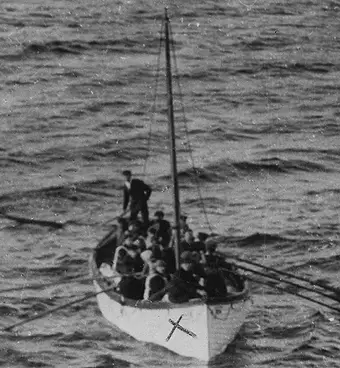
A close up of lifeboat 14 with Lowe standing. The sail has
now been taken in.
(Click to enlarge)
Lowe described at the British Inquiry putting the sail up, as he had likely done numerous times during his time on the Welsh coast:
"A breeze sprang up… I kept the sail up from then until I got alongside the “Carpathia,” and towed the collapsible and picked up the other collapsible - the sinking one…The sail might be improved…they be made without a dipping tack - that the tack be lashed abaft the mast, the same as ordinary lugsails…Besides that you want a man that knows something about dipping tack. You have to lower the sail and slacken the sheet before you can dip it." (British Inquiry)
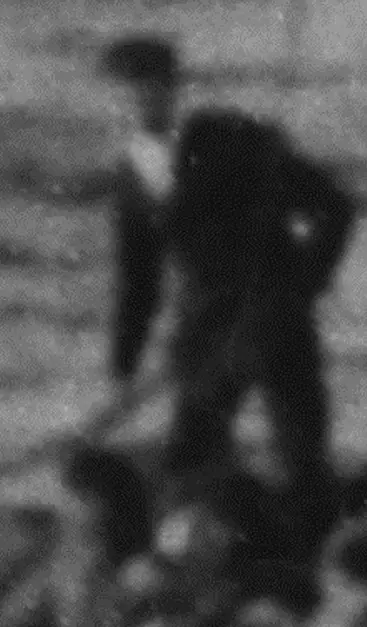
A close up on the figure of Fifth Officer Lowe at the helm of
Lifeboat 14 as it approaches the Carpathia. It is the only
known photograph of a Titanic officer in charge of a lifeboat.
The use of the sail had been noted by Sara Compton, who said that Lowe had correctly predicted a breeze would come up at dawn: "Officer Lowe insisted on having the mast put up. He crawled forward and in a few moments the mast was raised and ready. He said this was necessary as no doubt with dawn there would be a breeze." ("The Truth About the Titanic" by Archibald Gracie")
Evans believed that after sighting the Carpathia they were alongside her in "about 20 minutes" (US Inquiry). Lowe proudly stated that upon meeting the Carpathia "I landed everybody... And the corpse included."( US Inquiry)
Once all passengers were safely onboard Lowe met some of those he helped rescue and exchanged contact details:
I have lots of addresses here; but they are addresses of people who were in my boat… when we were on board the Carpathia I would go around and see - well, I don't know. I suppose you might deem them your friends; I suppose you could. They were very suddenly brought together, and all that. I used to go around among them; and I knew my boat crew. (US Inquiry, Day 5)
After all the lifeboats had been recovered, Captain Rostron made the decision to sail for New York, rather than Halifax, Titanic's intended destination.
That was not the end of Lowe's 'heroic efforts.' According to the April 23rd edition of Liberty magazine in an article written by survivor Renée Harris, a first class passenger who ended up in Collapsible D, who Lowe had taken in tow towards the Carpathia, the following occurred:
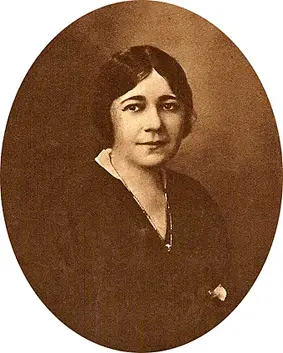
Renée Harris rescued in collapsible D, described
Lowe as "one of the finest men it has been
my privilege to meet." (Encyclopedia Titanica)
The day following I was put on deck with a few of the women who had tried, as I had, to be left to themselves. We were given a secluded corner. Two sailors with life belts on them came toward us. One of the women said, "Good God! What has happened now?" One of the sailors replied, "Nothing, lady. Someone wants to take pictures." And there, with a camera pointing toward us, were the aforementioned lord and lady.
Again the one to come to my rescue was the same officer who had manned the lifeboat that had saved the collapsible from sure destruction. In no uncertain words he told the titled couple what an Englishman thought of his own countrymen. Of course the pictures were not taken. If by some freak circumstance Fifth Officer Lowe should read these lines, he will know that through all the years he has stood out in my memory as one of the finest men it has been my privilege to meet." (Liberty magazine, "Her Husband Went Down with the Titanic" by René Harris, 23 April 1932
However the accuracy of her statement has been questioned by authors Gregg Jasper and Randy Bigham, who have written a biography of her life entitled "Broadway Dame: The Life & Times of Mrs. Henry B. Harris." An Encyclopedia Titanica article that accompanied the book concluded that "not all of it is factual....It’s doubtful that Fifth Officer Lowe would have done or said any of what Renée claimed. It was not his job to make a judgment about people taking pictures or to stop them from doing so. In fact, the photos were taken, but the Duff Gordons did not organize these lifeboat pictures or the wearing of the life jackets." (Encyclopedia Titanica)
Nonetheless, her wish that "Fifth Officer Lowe should read these lines" about his heroism was certainly at some point granted - in 2020 it was revealed at an auction of Lowe's family heirlooms that he owned a copy of her Liberty article.
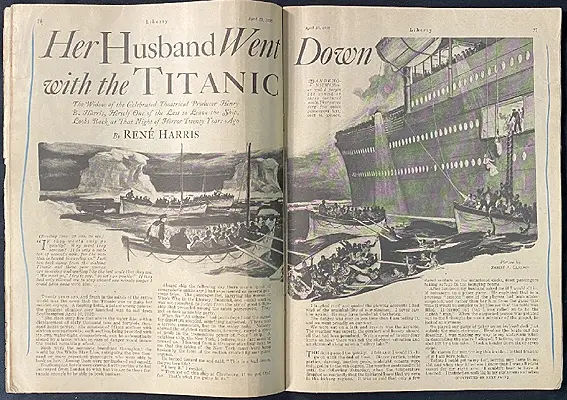
A copy of the Liberty Magazine dated 23rd April 1932 featuring an in depth account of the sinking by Mrs Harris, from the Lowe family archive put on auction in November 2020. (Henry Aldridge & Son Ltd)
Even if Renée Harris' story is not entirely accurate, she appeared in several newspaper articles shortly after the sinking, proclaiming Lowe as the "Real Hero of the Titanic" and perhaps revealing some bias:
In a short time I was being hoisted over the side of the Carpathia. In my stateroom that afternoon I said, "Who's that boyish chap that took command?"
"It was Fifth Officer Lowe of the Titanic," someone told me. I sent for him and then he came to my door I said, "Mr Lowe, you are wonderful. I want to thank you. I have no money but when I get to New York I want to reward you." He pushed up his cap. "I will never take money for doing my duty," he said. I made inquiries afterwards and learned he was Harold Godfrey Lowe, aged twenty-nine and a citizen of Perallt-Barmouth, North Wales. Since I have been in New York I have sent for him again and asked him to let me reward him. He flushed again and said, "Mrs Harris, you make me flush. I have only done my duty I won't take a penny for that. I only hollered. Anybody can holler."
He could not be moved. Ismay found that out, for Lowe is the officer who said when Ismay tried to direct the filling and lowering of a lifeboat; told him to go - well, somewhere else.
I have told this story because if Great Britain had only such seamen there would be no such disasters. And this was the first transatlantic crossing. He is one hero of the survivors of the Titanic. He is a brave, splendid youth to whom Great Britain should reward with a promotion. (New York Evening Journal 11 May 1912,courtesy "On Board RMS Titanic," by George Behe)

Illustration of Harold Lowe in Lifeboat 14 that accompanied Renée Harris' interview in The New York Evening Journal, May 11, 1912, in which she described him as the "real hero of the Titanic"
The day after arriving aboard the Carpathia, on April 16 1912, Hoyt's body was buried at sea from Carpathia according to The New York Times of 27 April 1912. Collapsible A, that Lowe allowed to drift away with three bodies in it, was recovered by the White Star Line's Oceanic almost a month later, on the 13th of May 1912. When it was recovered, there were three bodies still inside, described by an Oceanic passenger as 'two fireman and a passenger in evening dress.' (The Sun, 20 April 2016)

Collapsible A being recovered on the 13th of May, 1912(The Sun, 20 April 2016)
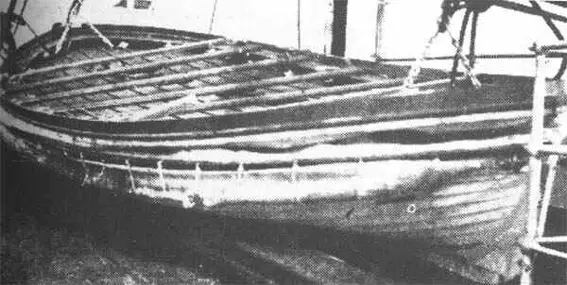
Inside the recovered lifeboat three bodies that Lowe had left were still there.
On the third day aboard the returning rescue ship, Lowe struck up a conversion and made an admission of sorts to Margaret Brown (who would become famously known as "Molly" Brown) who retrospectively frowned upon his judgment:
The third day on the Carpathia I talked at great length with one of the officers of the Titanic [Fifth Officer Lowe] who had had in his command five lifeboats, he having the one that went back and rescued those on the collapsible. In talking it over, he stated that they saw to it that, among those who were saved would not be any of the rich nabobs, again reiterating the same, adding, 'We saw to it that they would take their chances with good men.' While preening his feathers over this fact, he stated that there was one who got through without the officers knowing it. He later displayed his weapon and told how with that, he made one who persistently attempted to get in the boat with his wife, was told in the strong expletive of the masculine lexicon to 'chase himself around the deck.' He stated the only thing he regretted was the oaths he had used towards the ladies in the boats. (Newport Herald 28 and 29 May 1912 via "On Board RMS Titanic," George Behe)
Mrs Lily May Futrelle, first class, also conversed with Lowe aboard the Carpathia, during which he dramatically said he would rather have died in place of the men who lost their lives:
Illustrating the different kinds of heroism, there was the fifth officer. I think his name is Lowe. He kept his head and courage after the plunge of the Titanic, and stood by and picked up people until his boat had reached capacity. On the Carpathia he was always thinking of things to do for us. One day as we sat crying on deck he came up and said: 'You have all lost your husbands, haven't you?' And we answered 'Yes.' 'I hope you'll believe me, he said, 'when I tell you that I would give my life now to bring any one of them back. And I believed him. He did his duty - it didn't matter whether it was his duty to live for the rest of us or to die. (Philadelphia Evening Bulletin, April 1912, courtesy "On Board RMS Titanic," by George Behe)

A framed discharge certificate, allegedly Lowe's from his time aboard Titanic, that hangs in the Westminster Tea Rooms at 165 Lord Street, Southport.
See also...
Next... US & UK Inquiries